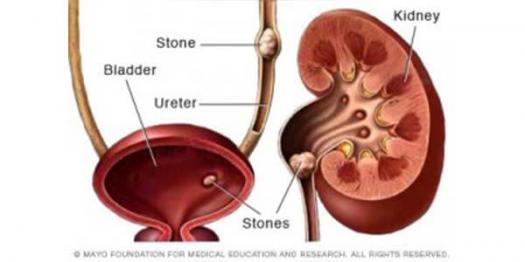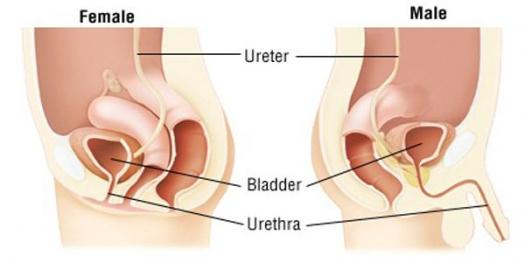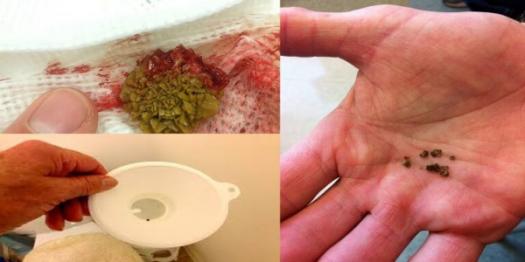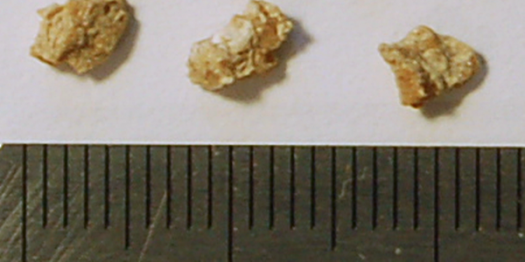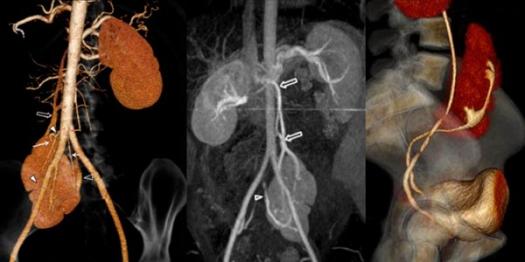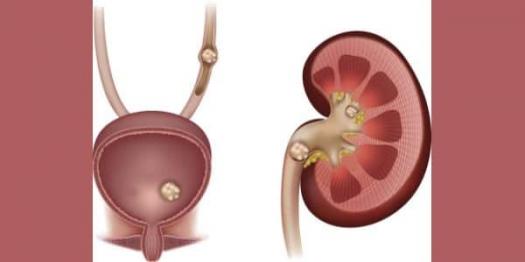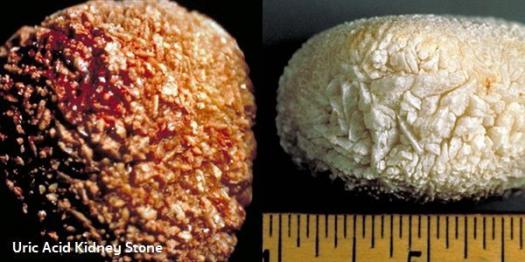How Well Do You Know Lithiasis Treatment?

Lithiasis or Calculus is a disease in which stones or smaller particles can be made in human body. You think you can score this test? Take your chances and find out!
- 1.
What is the general treatment for Lithiasis?
- A.
Drinking water
- B.
Removing the stone through the surgery
- C.
Breaking down the stones with medications
- D.
All of the above
Correct Answer
D. All of the aboveExplanation
The general treatment for Lithiasis involves all of the mentioned options. Drinking water helps in flushing out the stones and preventing their formation. Surgery is performed to remove larger stones that cannot be passed naturally. Medications are used to break down the stones into smaller pieces, making it easier for them to pass through the urinary tract. Therefore, all of the above options are part of the general treatment for Lithiasis.Rate this question:
-
- 2.
Which of the following methods is used for ureteral orifice dilatation during ureteroscopy?
- A.
Balloon - dilator
- B.
All of them
- C.
Plastic ureteral dilators
- D.
Dual-lumen ureteral catheter
Correct Answer
B. All of themExplanation
The correct answer is "All of them". This means that all the listed methods (balloon-dilator, plastic ureteral dilators, and dual-lumen ureteral catheter) are used for ureteral orifice dilatation during ureteroscopy.Rate this question:
-
- 3.
What is the treatment for renal stones?
- A.
Tunnel Surgery
- B.
Ureteroscope insertion
- C.
All of these
- D.
Extracorporeal Shock Wave Lithotripsy
Correct Answer
C. All of theseExplanation
The correct answer is "All of these." This means that all of the mentioned treatments (Tunnel Surgery, Ureteroscope insertion, and Extracorporeal Shock Wave Lithotripsy) are used for the treatment of renal stones. Each treatment option may be chosen based on the specific characteristics of the stones and the patient's condition.Rate this question:
-
- 4.
Which treatment is used for Lithiasis formed in Gallbladder?
- A.
Ureteroscopy
- B.
Percutaneous Nephrolithotomy
- C.
Extracorporeal Shock Wave Lithotripsy
- D.
Cholecystectomy
Correct Answer
D. CholecystectomyExplanation
Cholecystectomy is the correct answer because it is the surgical removal of the gallbladder, which is the treatment used for lithiasis formed in the gallbladder. Lithiasis refers to the formation of stones, known as gallstones, in the gallbladder. Cholecystectomy is a common procedure performed to alleviate symptoms caused by gallstones and to prevent complications such as inflammation of the gallbladder or blockage of the bile ducts. It involves the removal of the gallbladder, thereby eliminating the source of the lithiasis.Rate this question:
-
- 5.
For what is used Endoscopic ballistic lithotripsy?
- A.
Treatment of bladder calculi
- B.
Treatment of kidneys stones
- C.
Treatment of bile stones
- D.
Treatment of liver lithiasis
Correct Answer
A. Treatment of bladder calculiExplanation
Endoscopic ballistic lithotripsy is used for the treatment of bladder calculi. Bladder calculi are hard mineral deposits that form in the bladder. This procedure involves using an endoscope to visualize the stones and then using a ballistic device to break them into smaller pieces, making it easier for them to be expelled from the body. This treatment option is specifically designed for bladder stones and may not be suitable for other types of stones such as kidney stones, bile stones, or liver lithiasis.Rate this question:
-
- 6.
When is Percutaneous nephrolithotomy recommended?
- A.
If stones in kidney are very large
- B.
If other therapies have failed
- C.
If stones in the ureter are very large
- D.
All of the above is correct
Correct Answer
D. All of the above is correctExplanation
Percutaneous nephrolithotomy is recommended when the stones in the kidney are very large, when other therapies have failed, and when the stones in the ureter are very large. This procedure involves making a small incision in the back and using a nephroscope to remove or break up the stones. By selecting "All of the above is correct" as the answer, it indicates that all three conditions mentioned are valid reasons for recommending percutaneous nephrolithotomy.Rate this question:
-
- 7.
Which treatment is used for a small uric acid stone (up to 2cm in diameter) lodged in the renal pelvis?
- A.
Drinking more water
- B.
Percutaneous nephrolithotripsy
- C.
Alkalization of urine
- D.
Extracorporeal lithotripsy
Correct Answer
C. Alkalization of urineExplanation
Alkalization of urine is the correct treatment for a small uric acid stone lodged in the renal pelvis. Uric acid stones can form in acidic urine, so by alkalizing the urine, the stone can be dissolved or reduced in size. This can be achieved by administering medications such as potassium citrate or sodium bicarbonate to increase the pH of the urine. Drinking more water can help prevent stone formation, but it is not the treatment for an existing stone. Percutaneous nephrolithotripsy and extracorporeal lithotripsy are surgical procedures used for larger stones and are not suitable for a small uric acid stone.Rate this question:
-
- 8.
How long does it take the recovery after Open cholecystectomy?
- A.
Up to ten weeks
- B.
Up to eight weeks
- C.
Up to seven weeks
- D.
Up to six weeks
Correct Answer
D. Up to six weeksExplanation
The recovery time after an open cholecystectomy, which is the surgical removal of the gallbladder, can take up to six weeks. This is because the procedure involves making a large incision in the abdomen, which requires time for healing and for the patient to regain strength and mobility. During this recovery period, patients may experience pain, fatigue, and limitations in their daily activities. It is important for patients to follow post-operative instructions, take prescribed medications, and gradually increase their activity level to ensure a smooth recovery.Rate this question:
-
- 9.
How long does it take the recovery after Laparoscopic cholecystectomy?
- A.
Up to one week
- B.
Up to two weeks
- C.
Up to three weeks
- D.
Up to six weeks
Correct Answer
A. Up to one weekExplanation
The recovery period after a laparoscopic cholecystectomy, which is a minimally invasive surgical procedure to remove the gallbladder, typically takes up to one week. This is because laparoscopic surgery involves smaller incisions and results in less tissue trauma, leading to a faster recovery compared to traditional open surgery. However, individual recovery times may vary based on factors such as the patient's overall health, age, and any complications that may arise during or after the surgery.Rate this question:
-
- 10.
What is Lithotomy?
- A.
Nonsurgical method for removing stones from the body
- B.
Surgical method for removing stones from the body
- C.
Therapy for reduction of the calculi in kidney
- D.
Therapy for reduction of the gallstones
Correct Answer
B. Surgical method for removing stones from the bodyExplanation
Lithotomy is a surgical method for removing stones from the body. This procedure involves making an incision in the body and extracting the stones. It is commonly used to remove bladder or kidney stones. This method is considered more invasive compared to nonsurgical methods, but it is often necessary for larger or more complex stones that cannot be treated with other techniques.Rate this question:
-
Quiz Review Timeline +
Our quizzes are rigorously reviewed, monitored and continuously updated by our expert board to maintain accuracy, relevance, and timeliness.
-
Current Version
-
Mar 15, 2023Quiz Edited by
ProProfs Editorial Team -
Mar 16, 2018Quiz Created by
Zlatan Aleksic
- Abdomen Quizzes
- Addiction Quizzes
- Aging Quizzes
- Arthritis Quizzes
- Beauty Quizzes
- Blood Quizzes
- Body Quizzes
- Bone Quizzes
- Brain Quizzes
- Child Health Quizzes
- Dermatology Quizzes
- Digestive System Quizzes
- Disease Quizzes
- Fertility Quizzes
- First Aid Quizzes
- Hair care Quizzes
- Health And Nutrition Quizzes
- Health And Wellness Quizzes
- Health Policy Quizzes
- Health Psychology Quizzes
- Health Worldwide Quizzes
- Hearing Quizzes
- Heart Quizzes
- Hospital Quizzes
- Illness Quizzes
- Injury Quizzes
- Kidney Quizzes
- Liver Quizzes
- Lung Quizzes
- Medical Quizzes
- Mental Health Quizzes
- Nose Quizzes
- Nutrition Quizzes
- Obesity Quizzes
- Ophthalmology Quizzes
- Patient Quizzes
- Patient care Quizzes
- Pharmacy Quizzes
- Pregnancy Quizzes
- Puberty Quizzes
- Public Health Quizzes
- Respiratory System Quizzes
- Sleep Quizzes
- Stress Quizzes
- Surgery Quizzes
- Surgical Instruments Quizzes
- Throat Quizzes
- Weight Quizzes
- Wellness Quizzes
 Back to top
Back to top



